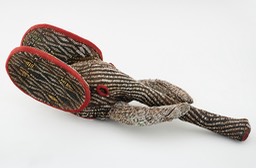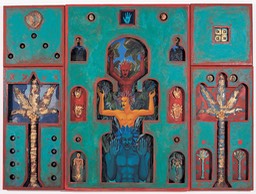Exhibits explore connections between African, Haitian art
Like creative “makers” everywhere, those from the African continent and diaspora are both practical and idealistic. They fashion objects to contain liquids and they fashion objects to contain spirits. They selectively design and embellish them to enhance their appeal to their markets and to their gods. Two excellent exhibitions closing their runs at the Lowe Art Museum this month raise intriguing questions about how objects are viewed and valued within different cultural contexts.
“Transformative Visions: Works by Haitian Artists from the Permanent Collection” and “Art in Real Life: Traditional African Art from the Lowe Art Museum” are physically and artistically connected by the African inspiration. Both shows draw on the Lowe Art Museum’s 19,000-piece, globally diverse collection. It is a South Florida treasure.
Director Jill Deupi said both shows “reflect the region’s panorama of heritages and faiths and beliefs” and encourage conversations about assimilation and acceptance. Community engagement is decidedly among Deupi’s priorities: enticing South Floridians, so infatuated with the new, to explore a collection that spans 5,000 years.
“Transformative Visions” was guest curated by University of Miami history and anthropology professors Kate Ramsey and Louis Herns Marcelin. Both are deeply engaged in Haiti’s culture, political developments, spiritual life and social-justice issues. They plumbed the Lowe’s collection and visited artists’ studios to select works for the exhibition. They also “cheated” by urging purchases — notably adding the first works by Haitian women.
In an email exchange, Ramsey wrote that the Lowe’s collection was “a particularly rich and interesting vantage point for examining how artists across different media have ‘personified’ the Vodou spirits — that is, imagined them in physical forms, embodied them.”
For her and Marcelin, she said, “‘Transformative Visions’ has a triple sense for us, referring to the transformative processes that went into making many of these works [i.e. salvage, recycling, repurposing]; the ways that numbers of these pieces thematize transformation in some way; and we hoped as well, the potential that the exhibition would transform narrow preconceptions associated with ‘Haitian art.’”
Although curation of the two exhibitions was not closely coordinated, “Transformative Visions” promotes engrossing comparisons with the figuration, patterning, color palettes and spiritual evocations of the much larger “Art in Real Life.”
Geometric patterning, for example, arises directly from beading, weaving, raffia work and stencil dyeing of Kirdi people’s aprons, Hausa hats and Bamun cloths. In Haiti, sequin designs decorate sacred objects, such as coverings for sacramental rum bottles and ceremonial drapo (flags) and are also used by priest/artists to create icon-like portraits and even narrative compositions, such as Myrlande Constant’s wildly imaginative and symbolically laden Points Saint Miel.
The distinctions between works created for ceremony and for sale are tenuous and shifting. Consulting curator Marcilene Wittmer, who has been involved with the Lowe since 1972, and responsible for recommending much of the Lowe’s African collection, said, “The germ of the exhibition was to show that African art is produced by artists: real live human beings who live and work in their own world — not for us.”
Western notions of aesthetics, narrative and other European conventions are often irrelevant. “Anthropologists and art historians have struggled with African languages to wring as many aesthetic words out of them as they can — with relatively little success,” she said.
Art to use
She characterized Africans’ fundamental attitude about art — even works made for religious ceremonies — as pragmatic. The old and rare are not prized the way they are in the West. And until recently, most works were unsigned; the object and its utility were more important than the maker. Whether altars, ritual garb, vessels, staffs or masks, “The works of art which they create and use are really tools, which they’re quite willing to sell, because they can easily create another thing to do it.”
Replacements can be “re-charged” through a ritual and made sacred again. Deupi referred to this phenomenon as “fungibility.” In Haiti, artworks created “for service” are generally more formalized, whereas those created for the art market have greater latitude of subject.
The global art market is now wielding its influence, and Miami audiences have recently been treated to works by African art stars Wangechi Mutu, El Anatsui, Chris Ofili and George Edozie — among others. Hopefully, this trend will continue. The African continent can illuminate many themes and motifs that underlie South Florida’s more pervasive Latin American and Caribbean art forms.
Spirit world’s relevance
Within “Transformative Visions,” regional visitors will find strong examples of familiar genres: colorful village market scenes, cut steel silhouette figures and diverse representations of Vodou spirits (lwas) from the pantheon of Haiti’s distinctive Afro-Christian syncretic religion. The spirit world’s underpinnings of daily activity and relevance to personal and national travails are hallmarks of Haitian art. Contemporary artists continually re-envision these dynamics in idiosyncratic ways.
Ramsey suggests that Edouard Duval-Carrié’s triptych Trois Feuillesresembles a Catholic altarpiece with windows cut out to reveal a layer of imagery just below the surface. Palm trees (including two prominent gold-leafed versions) anchor the work in the subtropics. Duval-Carrié, a well known South Florida artist, has stated that he often uses trees as stand-ins for himself. Three large male lwas are depicted in the central panel with leaves crowning their faces.
Ramsey cites a meditative Vodou song called Three Leaves. “Evoking histories of displacement, dislocation and loss, the song figures cultural remembrance as an active, transformative and potentially healing process. I think that Duval-Carrié’s piece does, too.”
André Eugène is a founder of the Grand Rue collective of artists in Port-au-Prince who unapologetically scavenge the urban landscape for detritus, which they transform into sculptural assemblages. Their work commonly critiques social inequities. In an uncharacteristically optimistic piece calledHaiti Will Not Perish, purchased this year by the Lowe, Eugène uses scrap wood, plastic, metal and tires to create a rough-hewn mother-and-child sculpture that responds with hope to the horror of the 2010 earthquake. The “Madonna” re-figures both the Black Madonna of Częstochowa — replete with the facial scarring of the original damaged icon — and Haiti’s protective lwa, Ezili Danto.
(Polish troops who were part of Napoleon’s expedition to suppress the Haitian revolution brought their patron saint’s image with them, and many switched sides to join the rebels.)
The theme of transformation infuses Pascale Monnin’s kinetic sculptureAnge de la Résurrection, in which clay becomes flesh through the direct molding and casting of a child’s face. Although she molds directly from live models, she doesn’t strive for realistic portraiture. “My intention is to question faces, imprints, and to search in the series to sense the humanity,” she said in an interview with Marcelin. In Ange, she bent heavy wires and hung them with strings of crystals and jewels to fashion radiant wings, thereby transforming the child into an angel. When the face accidentally cracked, rather than despair or attempt an invisible repair, Monnin embraced the gap and filled it with crystals: another transformation.
“You have to live with scars,” she said. “We have to wear them as jewels.” Illuminated from below, the sculpture creates shadow figures that float three-dimensionally on adjacent walls. The piece was purchased in honor of the August retirement of Brian Dursum as director and chief curator after 24 years.
Ramsey explained that while drapo have long served in Vodou ceremonies to greet and honor the lwas, priest and South Florida artist Clotaire Bazile began to create and sell his drapo as works of art in the 1970s. In an interview recorded by Anna Wexler, he explained that the lwas he served closely guided and inspired his art, and the money provided for his worship community as well as his family.
Textiles prominent
Fabrics are also prominent in “Art in Real Life,” and according to Wittmer, textiles may be more important than sculpture in African art. “What I tried to do is show the variety of media,” Wittmer said.
The Asafo Flag, made by the Fante people of Ghana, was designed for a military association. It depicts the commander in a yellow jacket, studded with insignia. He points at one pair of soldiers cooperating successfully in a task, whereas another tips over, trying to work by himself. Such flags often illustrate proverbs while also identifying a social group and representing authority and prestige.
Other fiber works, made of beads, raffia, wool, woven cotton and other materials, show a range of applications, designs, techniques and palettes, including complex indigo dyes and earthy ochres that contrast with the brilliant synthetic colors of the mid-20th century flag.
The curvilinear forms of baskets, gourds and pottery provide opportunities for careful comparison of shape and decoration. Scholarly wall texts abound, although many African objects remain unsigned and undated. And their beauty remains timeless.
The mingling and interpenetration of spiritual and secular objects — dolls, jewelry, altars, smoking pipes, ceremonial knives or barbershop signs — is characteristic of exhibitions at the Lowe that mine its eclectic collection. A recent example was its Qing Dynasty show (bit.ly/HeraldChinese). According to the new director, interweaving themes from past and present will continue to distinguish the Lowe’s programs. “I’m not interested in becoming a museum of contemporary art,” Deupi said, “but to tell the whole story of art history and culture. ... I think it’s critical to remain relevant and to continue to grow that story here at the Lowe, rather than remaining static.”
The Fundación Jumex collaboration is a teaser, and upcoming exhibitions by social activist photographer Vik Muniz (Feb. 7) and another presenting the textile arts and the personal narratives of Southeast Asian women (Jan. 31) will further flesh out that vision.
IF YOU GO
What: ‘Transformative Visions: Works by Haitian Artists from the Permanent Collection’
Where: Lowe Art Museum, University of Miami, 1301 Stanford Dr., Coral Gables
When: Through Jan. 18.
Info: 305.284.3535; www.lowemuseum.org; cost: $3 to $10
What: ‘Art in Real Life: Traditional African Art from the Lowe Art Museum’
When: Through Jan. 11
Also: ‘1+2 Colección Jumex in Dialogue with the Lowe Museum’ through May 24. Eleven contemporary works from the Jumex Museum in Mexico City are paired with historical works from the collection.
To hear Jill Deupi and Marci Wittmer go to bitly.com/Herald_LoweArtMuseum

